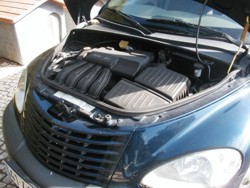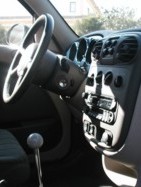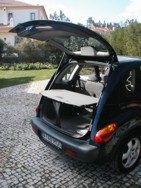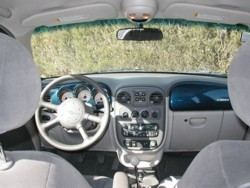A hard thing to do is trying to select a car...
Lancia Lybra SW

The PT Cruiser

The choices were few. I needed a car with enough space to do things as to get my dogs to the vet or for my wife to buy some plants at the local shed or to go to the supermarket by the end of the week. That dictates either a break or a compact. On the other hand aesthetics, performance and comfort were also a concern, because I don't like to get in a car that I find ugly or that lacks road capability, and this type of car is often used for long trips so comfort is a must. Equipment was taken into account and electronic automated systems were preferred because of its inherent reliability.
Looking at the market in terms of breaks I liked the Lancia Lybra, the Alfa 156 being too cozy for my tastes and the Renault Laguna II was put aside for reliability concerns after a quick Internet search and from rumors I heard. My wife on the other was enthusiastic on the Chrysler PT Cruiser since she first saw one, and I must say I was very inclined to its neo-retro looks. The Lybra is a little neo-retro too, but on the classic European side, and I was already a Fiat customer (Barchetta) so the dialogue with the technical assistance was easy. So, the Lybra and the PT Cruiser were selected for road-tests. Another concern was no Diesel at all, because of its environmental impact (noisy, less carbon monoxide but more fumes). A 2.0 engine was targeted.
It was impossible to obtain a 2.0 Lancia Lybra for evaluation. The 2.0 version is not sold any more in Portugal, but Fiat Auto had one new, so I asked for it to be reserved while evaluating. There was not an available similar vehicle at the stand for an entire day test, just for a quick drive. The public relations department of Fiat Auto Portuguesa lent me a 1.6 SW for 3 days, so I could really get the feeling of it.
The car looks good (in spite my wife is not enthusiastic about it, she says it's "just another break") and has a generous space inside, even for somebody coming from a Laguna I. The first thing that impressed me was the sensation of silence when I put the engine working. When noise was measured it proved to be some 51dBA, even lower than the Laguna at 53dBA. The spectral character of the noise is also different, contributing to the silence sensation.
The engine is I would say a little under-dimensioned for this car, so gearbox is scaled accordingly. 3000rpm in 4th gives about 85km/h and 4000 in 5th makes the car go to 130km/h. It therefore tends to be noisier than an equivalent model with a larger capacity engine. In spite of that, the car responds quite well. I may be eccentric, but my real performance test is not 0-100km/h or something of the kind. It is going to a 7% grade very long climb, get the car in 4th at the base and see where I can change to fifth and what is the maximum speed I can get into both 4th before changing and fifth after change. In the case of the Lybra I could change to 5th comfortably at 120km/h and the car firmly kept 110km/h up the hill. Not bad for a 1.6 engine. My Laguna does 115Km/h max in 4th, and if you change to 5th it will get up the hill at some 85km/h, constantly loosing speed. This test exercises both low-rpm torque and maximum torque which usually occurs between 3500 and 4500rpm on petrol engines. This version of the Lybra showed quite a constant torque in spite it does not resort to variable valve angles to do it like on the 1.8 and 2.0 engine versions.
The car is quite well equipped with things as a fully automatic A/C with dual-zone, tiny lights everywhere, an excellent radio which screen is a large LCD grouped with a trip computer, which also shows you the doors which are open, allows you to set a speed limit, and so on. The quality of the speakers was not a top one, there was a definite lack of both audio bandwidth extremes, leaving room for improvement (I set everything to flat for evaluation purposes). A CD box was provided in the trunk, and the thing had an obsolete cassette player, not really useful for me...There were on-wheel radio commands and FM muting when a tunnel was entered was correct and smooth.
On the instrument panel I could find very useful things like burnt-out lamp indicators, avoiding you periodic inspections. Another feature was a remote-control opened trunk door, and I found that one could get his/her arm (I tried it after a first trial with some cardboard :o) into the window while closing it. The front window open/close buttons required only a pulse to operate and all the windows were motorized. When I got out of the car at night I found that the floor was well lighted due to a light in the lower part of the front doors. Another convenient thing I found was that I could have the alarm (it had a factory alarm) engaged and still open the trunk with the radio control. The electronics disengage the alarm and then re-engage it upon closure.
The demisting feature of the automatic A/C was a thing I was used from the Laguna and that I appreciated on the Lybra as well (it is fully automatic on the 2.0 LX).
Fuel consumption was around 10l/100Km on mixed use. I normally do only highways, some 100km/day (will be much less by the end of the year) but I normally have heavy traffic on 2 or 3 different spots when changing roads.
The trunk space is not huge as is the one on the Laguna I, but will accommodate a 1.00x0.75x0.70 volume easily. There is a space for a subwoofer in the trunk, factory-fitted together with a Bose audio system of much higher quality on the LX, which was the model I was looking forward to buy.
I noticed that on the rear armrest there was a door to insert some long object without having to fold down the seats. The seats were comfortable with the exception of the back ones, which were a real pain...Negative note here, nobody can travel on those seats without being a masochist, you sit down and immediately feel that you hit the bottom...That version was a tissue one, I tried a leather back seat and it was quite different (the LX has leather seats). I found the drive seat regulation very awkward. Pump-like mechanics for up-down, lever for tilt and electric (!) for back support.
Finally handling on the road was good, you just had to wait a little for the engine to catch up or in alternative use higher revs. Suspension was a very good compromise, fantastic on stone-paved roads, wobbling just a little after a large bump and with enough stability for the vehicle type. Breaking was correct and efficient
The engine compartment had nothing to see, just a huge plastic cover over the engine, but surprise, hydraulic cover lifters! I would rather prefer to see all the stuff, but I have to understand that sound-proofing an engine is not easy.
The car curves easily, with no strange behavior, the wheel is well assisted, but I would prefer a tighter radius for maneuvering purposes. To resume, I generally liked the car, and loved those little interior details. The car is truly a luxury one even on starting versions.

Upon opening the door with the command only the driver door opened. The car came to my hands without an instruction manual, and I only learned later that I had to click twice to open everything, just like in a Ford or Land Rover...When you insert the key with the door open you receive a loud warning tone, that only shuts off when you shut the door. Extremely irritating thing, I believe there is a way of defeating it, but don't know how, so I had to cope with it.
The car has a nice retro interior, apart from the central console, which I consider a stain in the otherwise well-accomplished design. Lots of hard-plastic inside but it is of very good quality, nothing to say. Totally different from the Lancia, where the materials were very noble (even with wood trims). A younger look.
The seats were comfortable, the back seat was useable without being a model of comfort, but much better than the one of the Lancia. No armrest was however present and the central back "seat" was hard. Electric up-down was provided on the driver seat, mechanical tilt, but no back support.
The space inside was found amazingly modular, all seats fold without the need of taking the head rests off, and you can even remove the seats very easily. The back trunk drawer even doubles as a table, very good for picnics or just as a tool support if you need to do a remote intervention. The trunk can accommodate a 0.95x0.80x0.50 object, but the 0.50 can be extended at ease to 1.40 by taking seats out of the way. The trunk drawer is useful otherwise you would have to pile up when going to the supermarket (space in height rather than in depth).
The driving position is high, so you have to slightly climb up to get to the seat and not drop on the seat as on the Lancia. Front visibility is good and the driving position is excellent in spite not so relaxed as in the Lancia. One is a little surprised upon starting the engine, because of its characteristic roar, at 54dBA. If you were expecting something similar to a hot-rod, that will increase the level of your expectations. You have however to fully press the clutch to get the motor running, which is a good practice on all cars. The engine roar will of course increase with revs, without getting excessive. At 4000rpm it will be at loud speech level (72dBA).
Performance on the 7% grade was lousy. The car could not pass 110km/h in 4th and 5th can not be engaged at all. The motor has no torque at low rpm, and attains its maximum torque at 4200rpm, in contrast with 3700rpm on the Lancias. I tried to correlate this also to the gearbox, and got 95km/h at 3000rpm in 4th and 150km/h at 4000rpm in 5th, which means we have a combination of a very long gearbox with a peaking at high-rpm torque curve, meaning you have to drive revs up or be patient. This is a car good for the desert plains...
It is however a very funny car to drive, making you feel great. Suspension is firm but generally acceptable in comfort terms, despite being terrible on stone roads especially when curving (the back jumps a little, it has a rigid axle as compared with the Lancia independent concept). Very good coming out of road bumps, never wobbles. The car curves very easily, the wheel is well assisted and the security sensation is total.
Breaking was fair, but the version I tested had drums on the rear, unlike the sought LE, which has discs
The traction control exists but can not be detected as in other cars (I once rented a so-equipped WW Polo with it and sweared I would never buy a car with that thing on!). It seems that it can be put out as well if needed.
The radio is I would rather say a re-edition of a 70's model :o). Small potentiometers for regulation of bass and treble, large pot for volume, electro-luminescent display (I didn't saw one for ages...) You only have a clock when you have the radio off, because it is on the radio display. The same kind of display is used on the odometer, which has the convenience of serving as a fault display when its button is pressed while the key is engaged to the on position. The speaker quality is very good in spite of not having a sub-woofer. You will hardly ever need one. The radio does not mute properly in FM mode (sshhhh when you enter a tunnel). It has a front-loading CD player and the legacy cassette player which serves no purpose to me.
There is a compass on the ceiling grouped with the outside thermometer
When you must get the key out you have to press a hard button. This is a complete nonsense on my point of view and only serves the purpose of making things difficult for the driver.
I had heard before that the engine had excessive oil consumption. Coincidence or not, the engine oil level was below minimum when I checked it... Fuel consumption was around 11l/100Km.
The car showed some small chips on the paint. All had rust. Light rust could be also observed on screws and certain parts of the underside. The front tires showed a strange wear, more in the center than on sides, as when you apply excessive pressure for a long time. The engine bay is a delight to see because of the font exhaust collector. However the battery is small and hidden beneath the air filter. There is almost no space left in the engine compartment.
The manual A/C was tested at 20ºC and even at maximum fan and minimum temperature the cold air was not excessive, leaving some doubts that it will effectively work in the Summer.
Finally, I conducted the anti-smashing test on the windows. Those only work with a touch opening, never closing, and I could see why...no anti-smash is fitted.




Epilogue
A comparative noise table (All noise figures are in dbA)
| RPM | Laguna I | Lybra | PT Cruiser |
| 1000 | 53 | 51 | 54 |
| 2000 | 55 | 57 | 59 |
| 3000 | 66 | 64.5 | 65 |
| 4000 | 70 | 72 |
